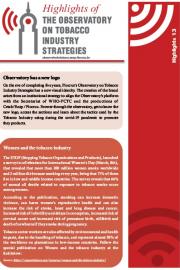
fact sheets with the topics considered outstanding in order to promote debates and decision making in the scope of tobacco control. In this edition, the following points are presented: Observatory has a new logo; women and the tobacco industry; slavery work; Cadernos de Saúde Pública and Rock in Rio and Souza Cruz are condemned for abusive advertising of tobacco products to young people.
KORNALEWSKI, Alex Medeiros; CARVALHO, Alexandre Octavio Ribeiro de; BARATA, Danielle; LEONEL, Filipe; TURCI, Silvana Rubano. Destaques do Observatório sobre as Estratégias da Indústria do Tabaco. Cetab/Ensp/Fiocruz, Rio de Janeiro, mai. 2021. Acesso em: 5 maio 2021.
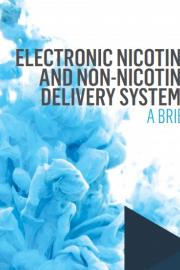
Os sistemas eletrônicos de entrega de nicotina e não nicotina (EN e NNDS) são uma classe heterogênea de produtos que use uma bobina eletricamente alimentada para aquecer e transformar um líquido em um aerossol, que é inalado pelo usuário. Embora as consequências dos efeitos de longo prazo sobre a morbidade e mortalidade ainda não tenham sido
estudados suficientemente, esses dispositivos não são seguros para jovens, mulheres grávidas e adultos que nunca fumaram.
WORLD HEALTH ORGANIZATION. Electronic nicotine and non-nicotine delivery systems: a brief. Dinamacar, 2020. Disponível em: https://www.euro.who.int/__data/assets/pdf_file/0009/443673/Electronic-n.... Acesso em: 12 mar. 2021.
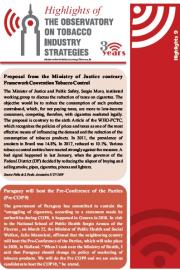
Fact sheets with topics considered prominent in order to promote debates and decision-making in the scope of tobacco control. In this edition, the following points are presented: proposal of the Ministry of Justice opposes the Framework Convention; Paraguay to Host Pre-Conference of Parties - COP9; representatives of the tobacco industry seek support from the Ministry of Agriculture; FDA wants new regulation for electronic cigarettes.
KORNALEWSKI, Alex Medeiros; CARVALHO, Alexandre Octavio Ribeiro de; CARVALHO, Daniel da Costa e Silva de; BARATA, Danielle; LEONEL, Filipe; TURCI, Silvana Rubano. Destaques do Observatório sobre as Estratégias da Indústria do Tabaco. Cetab/Ensp/Fiocruz, Rio de Janeiro, out. 2017. Acesso em: 30 out. 2017.
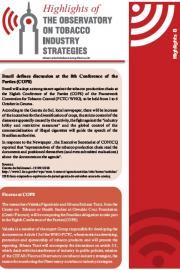
Highlights with topics considered prominent in order to promote debates and decision-making in the scope of tobacco control. In this edition, the following points are presented: Brazil sets standards for the 8th Conference of the Parties; Fiocruz in the COP 8; Tobacco control groups appeal to civilian house and tobacco industry sends representative to Congress of Medicine.
KORNALEWSKI, Alex Medeiros; CARVALHO, Alexandre Octavio Ribeiro de; CARVALHO, Daniel da Costa e Silva de; BARATA, Danielle; LEONEL, Filipe; TURCI, Silvana Rubano. Destaques do Observatório sobre as Estratégias da Indústria do Tabaco. Cetab/Ensp/Fiocruz, Rio de Janeiro, nov. 2017. Acesso em: 11 dez. 2017.
Background: The tobacco industry works to block, delay and weaken national tobacco control legislation to implement the FCTC. This paper reviews how Nepal overcame industry opposition and to a comprehensive tobacco control law implementing the FCTC.
Methods: We triangulated newspaper articles and policy documents with key informant interviews.
Results: With the support of international health groups, local tobacco control advocates worked with policymakers in Nepal to pass a comprehensive tobacco control law that exceeded FCTC obligations. The tobacco industry exploited a time of political transition to block consideration by Parliament, arranged and sponsored foreign tours for legislators, made death threats to tobacco control advocates and their families, and argued for the economic importance of tobacco farms. Despite strong interference from Health, and Law and Justice ministers, a 2009 Supreme Court ruling helped tobacco control advocates secure a comprehensive tobacco control law in 2011 that included rotating pictorial health warning labels covering 75% of both sides of cigarette packages, 100% smoke free public places and workplaces, private homes and vehicles, and a tobacco advertising, promotion and sponsorship ban.
Conclusions: Advocates in developing countries should utilize Nepal's experience to reject tobacco industry offers of compromise and continue educating politicians and legislators to generate political support to pass a comprehensive tobacco control law. Technical and financial support from international agencies, and effective collaboration and coordination of civil societies, and utilization of domestic litigation are helpful in LMICs where governance is weak.
Implications: The tobacco industry exploited a time of political transition in Nepal in its effort to block comprehensive tobacco control policy in Parliament by sponsoring foreign tours of legislatures, making death threats to tobacco control advocates and their families, and arguing for the economic importance of tobacco farms. Tobacco control advocates used litigation to raise awareness and educate legislators, and promote strong legislation with the involvement of international health groups. Technical and financial support from international agencies, and effective collaboration and coordination of civil societies, and utilization of domestic litigation are helpful in LMICs where governance is weak.
BHATTA, D. N. et al. Exceeding FCTC obligations: Nepal overcoming tobacco industry interference to enact a comprehensive tobacco control policy. Nicotine & Tobacco Research: Official Journal of the Society for Research on Nicotine and Tobacco, Reino Unido, v. xx, n. xx, p. 1-11, set. 2019.
Introduction: Nepal passed a comprehensive tobacco control law in 2011. Tobacco control advocates successfully countered tobacco industry (TI) interference to force implementation of law.
Aims and Methods: Policy documents, news stories, and key informant interviews were triangulated and interpreted using the Policy Dystopia Model (PDM).
Results: The TI tried to block and weaken the law after Parliament passed it. Tobacco control advocates used litigation to force implementation of the law while the TI used litigation in an effort to block implementation. The TI argued that tobacco was socially and economically important, and used front groups to weaken the law. Tobacco control advocates mobilized the media, launched public awareness campaigns, educated the legislature, utilized lawsuits, and monitored TI activities to successfully counter TI opposition.
Conclusions: Both tobacco control advocates and the industry used the discursive and instrumental strategies described in the PDM. The model was helpful for understanding TI activities in Nepal and could be applied to other low- and middle-income countries. Civil society, with the help of international health groups, should continue to track TI interference and learn the lessons from other countries to proactively to counter it.
Implications: The PDM provides an effective framework to understand battles over implementation of a strong tobacco control law in Nepal, a low- and middle-income country. The TI applied discursive and instrumental strategies in Nepal in its efforts to weaken and delay the implementation of the law at every stage of implementation. It is important to continuously monitor TI activities and learn lessons from other countries, as the industry often employ the same strategies globally. Tobacco control advocates utilized domestic litigation, media advocacy, and engaged with legislators, politicians, and other stakeholders to implement a strong tobacco control law. Other low- and middle-income countries can adapt these lessons from Nepal to achieve effective implementation of their laws.
BHATTA, D. N. et al. Defending comprehensive tobacco control policy implementation in Nepal from tobacco industry interference (2011-2018). Nicotine & Tobacco Research: Official Journal of the Society for Research on Nicotine and Tobacco, Reino Unido, v. xx, n. xx, p. 1-10, abr. 2020.
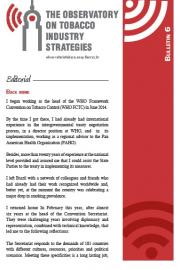
Bulletin six published by the Tobacco and Health Studies Center of the Sergio Arouca National School of Public Health of the Oswaldo Cruz Foundation (Cetab / Ensp / Fiocruz). This edition is composed of an editorial signed by Vera Luiza da Costa e Silva, former head of the Secretary of the Framework Convention for Tobacco Control - WHO, in addition to containing the following texts: Observatory on tobacco industry strategies completes 4 years and launches section on Covid-19; Summary of STOP monitoring: tobacco industry responses to the Covid-19 pandemic and the radar section with the latest reports.
BACK home [bulletin SIX]. Cetab/Ensp/Fiocruz, Rio de Janeiro, n. 6, 26 jun. 2020.
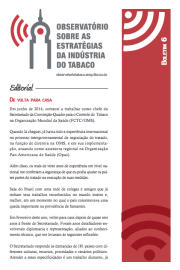
Boletim seis publicado pelo Centro de Estudos sobre Tabaco e Saúde da Escola Nacional de Saúde Pública Sergio Arouca da Fundação Oswaldo Cruz (Cetab/Ensp/Fiocruz). Esta edição é composta por um editorial assinado por Vera Luiza da Costa e Silva, ex-chefe do Secretariado da Convenção-Quadro para Controle do Tabaco – OMS, além dos textos: Observatório sobre estratégias da indústria do tabaco completa 4 anos e lança seção sobre a Covid-19; Resumo do monitoramento STOP: respostas da indústria do tabaco à pandemia da Covid-19.
DE volta para casa [boletim SEIS]. Cetab/Ensp/Fiocruz, Rio de Janeiro, n. 6, 26 jun. 2020.
Objective: To measure the implementation of WHO Framework Convention on Tobacco Control (FCTC) Article 5.3 at country level using a new Tobacco Industry Interference Index and to report initial results using this index in seven Southeast Asian countries.
Methods: Score sheet based on WHO FCTC Article 5.3 Guidelines sent to correspondents in seven Southeast Asian countries, using a scoring system designed with the help of tobacco control experts and validated through focused group discussions.
Results: The seven countries ranked from the lowest level of interference to the highest are Brunei, Thailand, Lao PDR, Cambodia, Philippines, Malaysia and Indonesia. Countries that face high levels of unnecessary interaction with the tobacco industry also face high levels of tobacco industry influence in policy development. Most governments do not allow any tobacco industry representatives on their delegation to sessions of the Conference of the Parties or its subsidiary bodies nor accept their sponsorship for delegates, but most governments still accept or endorse offers of assistance from the tobacco industry in implementing tobacco control policies. Most governments also receive tobacco industry contributions (monetary or in kind) or endorse industry corporate social responsibility activities. Governments do not have a procedure for disclosing interactions with the tobacco industry, but Lao PDR, Philippines and Thailand have instituted measures to prevent or reduce industry interference.
Conclusions: This Tobacco Industry Interference Index, based on the WHO FCTC Article 5.3 Guidelines, is a useful advocacy tool for identifying both progress and gaps in national efforts at implementing WHO FCTC Article 5.3.
ASSUNTA, M.; DOROTHEO, E. U. SEATCA Tobacco Industry Interference Index: a tool for measuring implementation of WHO Framework Convention on Tobacco Control Article 5.3. Tobacco Control, Reino Unido, v. 25, n. 3, p. 313–318, maio 2016.